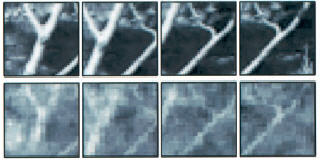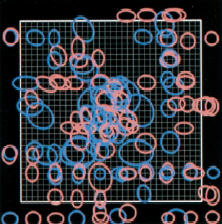Science Fiction
Dictionary
A B C D E F G H I J K L M N O P Q R S T U V W X Y Z
Jack Into A Cat's Brain

What is the Matrix? In this case, it is a 64x64 array produced by linear decoding, that reconstructs spatiotemporal visual inputs from ensemble responses in the lateral geniculate nucleus (LGN) of sharp-eyed cats. From the responses of 177 brain cells, they were able to reconstruct time-varying natural scenes with recognizable moving objects.

(From Cat Brain Video - bottom set)
In this 1999 study, Garett B. Stanley, Fei F. Li and Yang Dan have literally jacked into the mind of a cat. Multiple cells in the LGN of anesthetized cats were recorded simultaneously with multielectrodes. The spike trains of the neurons were binned according to the frame rate of the stimulus (32 Hz for movies, 128 Hz for white noise) and converted to firing rate signals. They recorded the responses of the cells to multiple repeats of eight short movies, and these data were used for subsequent analyses. The geniculate cells were well driven by the movie stimuli, as indicated by their mean firing rates, which were higher during movie presentation than in the absence of visual stimuli.

(From Cat Brain Neuron Set)
When science fiction fans think about examples in which one person can directly experience (or see) and record the internal experience of another person, they usually think about Neuromancer, the 1984 novel by William Gibson. In the novel, he refers to simstim:
Cowboys didn't get into simstim, he thought, because it was basically a meat toy. He knew that ... the cyberspace matrix was actually a drastic simplification of the human sensorium, at least in terms of presentation, but simstim itself struck him as a gratuitous multiplication of flesh input.
The cyberspace matrix, according to the book, "has its roots in primitive arcade games... in early graphics programs and military experimentation with cranial jacks."
As far as I know, the first science fiction author to describe a mechanical process for viewing and recording the thoughts of another person (as opposed to a purely mental "ability" - namely, telepathy) was Cordwainer Smith. In his 1958 story No, No, Not Rogov!, he writes about an espionage machine that can let one person see the thoughts of another:
He had then turned away from the reception of pure thought to the reception of visual and auditory images. Where the nerve-ends reached the brain itself, he had managed over the years to distinguish whole packets of microphenomena, and on some of these he had managed to get a fix.
(Read more about the espionage machine)
Read more from the orginal paper (Reconstruction of Natural Scenes from Ensemble Responses in the Lateral Geniculate Nucleus - pdf); original post at Extracting video from cat brains. Thanks to alert reader Justin Kennedy for pointing this story out.
Scroll down for more stories in the same category. (Story submitted 7/6/2005)
Follow this kind of news @Technovelgy.| Email | RSS | Blog It | Stumble | del.icio.us | Digg | Reddit |
Would
you like to contribute a story tip?
It's easy:
Get the URL of the story, and the related sf author, and add
it here.
Comment/Join discussion ( 3 )
Related News Stories - (" Biology ")
Black Fungus Blocks Radiation
'You were surrounded by Astrophage most of the time' - Andy Weir, 2021.
Lunar Biorepository Proposed For Cryo-Preservation Of Earth Species
'...there was no one alive who had ever seen them. But they existed in the Life Bank.' - John Varley, 1977.
Let's Make Slaver Sunflowers! Engineering Plants To Reflect Light
'The mirror-blossom was a terrible weapon.' - Larry Niven, 1965.
Machete-Wielding Philodendron Isn't Going To Take It Anymore
'The tree ended its wild larruping, stood like a dreaming giant liable to wake into frenzy at any moment.' - Eric Frank Russell, 1943.
Technovelgy (that's tech-novel-gee!) is devoted to the creative science inventions and ideas of sf authors. Look for the Invention Category that interests you, the Glossary, the Invention Timeline, or see what's New.
Science Fiction
Timeline
1600-1899
1900-1939
1940's 1950's
1960's 1970's
1980's 1990's
2000's 2010's
Current News
Amazon Will Send You Heinlein's Knockdown Cabin
'It's so light that you can set it up in five minutes by yourself...'
Is It Time To Forbid Human Driving?
'Heavy penalties... were to be applied to any one found driving manually-controlled machines.'
Replace The Smartphone With A Connected Edge Node For AI Inference
'Buy a Little Dingbat... electropen, wrist watch, pocketphone, pocket radio, billfold ... all in one.'
Artificial Skin For Robots Is Coming Right Along
'... an elastic, tinted material that had all the feel and appearance of human flesh and epidermis.'
Robot Guard Dog On Duty
I might also be thinking of K-9 from Doctor Who.
Wearable Artificial Fabric Muscles
'It is remarkable that the long leverages of their machines are in most cases actuated by a sort of sham musculature...'
BrainBridge Concept Transplant Of Human Head Proposed
'Briquet’s head seemed to think that to find and attach a new body to her head was as easy as to fit and sew a new dress.'
Google's Nano Banana Pro Presents Handwritten Math Solutions
'...copy was turned out in a charming and entirely feminine handwriting.'
Edible Meat-Like Fungus Like Barbara Hambly's Slunch?
'It was almost unheard of for slunch to spread that fast...'
Sunday Robotics 'Memo' Bot Has Unique Training Glove
'He then started hand movements of definite pattern...'
Woman Marries Computer, Vonnegut's Dream Comes True
'Men are made of protoplasm... Lasts forever.'
Natural Gait With Prosthetic Connected To Nervous System
'The leg was to function, in a way, as a servo-mechanism operated by Larry’s brain...'
Spidery 'Walk Me' Toyota Autonomous Wheel Chair Like Star Wars
Walk along with the emperor.
Proof Of Robothood - Not A Person
'Who are you people? - Show 'em.'
Dancing Robots Taught Dance Moves
'A clockwork figure would be the thing for you...'
Indonesian Clans Battle
'The observation vehicle was of that peculiar variety used in conveying a large number of people across rough terrain.'
